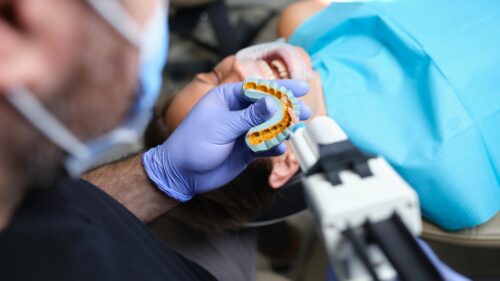As dental professionals in the UK, selecting the right impression material is a critical decision that directly impacts the accuracy of diagnoses and the success of subsequent treatments. Alginate and silicone are two commonly used impression materials, each with its own set of advantages and considerations. In this comprehensive guide, we will delve into the differences between Alginate and silicone impression materials, shedding light on their properties, applications, and best practices.
- 1 Introduction to Dental Impressions
- 2 Alginate Impressions: Overview and Characteristics
- 3 Silicone Impressions: Types and Characteristics
- 4 Comparative Analysis: Alginate vs. Silicone Impressions
- 5 Best Practices for Using Alginate and Silicone Impressions
- 6 Conclusion: Tailoring Impressions to Clinical Needs
Introduction to Dental Impressions
Dental impressions serve as a crucial step in the diagnostic and treatment planning process. These impressions capture the unique structures of a patient’s oral cavity, providing dental professionals with a detailed replica for analysis and the creation of custom restorations. Alginate and silicone are among the primary materials employed for this purpose, each possessing distinct characteristics.

Alginate Impressions: Overview and Characteristics
Composition and Setting Time
Alginate is a hydrocolloid material derived from seaweed. Its popularity in dentistry stems from its ease of use and cost-effectiveness. Alginate powder is mixed with water to create a viscous, gel-like substance that can be easily manipulated. One notable characteristic of Alginate is its relatively fast setting time, making it a preferred choice for quick impressions.
Applications in Dentistry
Alginate impressions find widespread use in various dental procedures, particularly for preliminary impressions, diagnostic casts, and the creation of study models. Their ability to capture intricate details, combined with ease of use, makes Alginate a valuable instrument for situations where a high level of precision is not the primary concern.
Considerations for Alginate Impressions
While Alginate offers several advantages, it is essential for dental professionals to consider its limitations. Alginate impressions are sensitive to moisture and can distort if not handled carefully. Additionally, they are best suited for short-term use, and their accuracy may diminish over time.
Silicone Impressions: Types and Characteristics
Composition and Varieties
Silicone impression materials belong to the elastomer category and are known for their stability and accuracy. They are available in various types, including addition silicone (polyvinyl siloxane or PVS), condensation silicone, and polyether. Addition silicone, often referred to as vinyl polysiloxane (VPS), is the most widely used type due to its superior properties.
Dimensional Stability and Accuracy
One of the key advantages of silicone impressions, especially addition silicone, is their excellent dimensional stability. These materials exhibit minimal shrinkage upon setting, ensuring that the replica closely mirrors the oral structures. Silicone impressions are known for their accuracy and are frequently employed in situations where precision is paramount.
Applications in Dentistry
Silicone impressions are versatile and suitable for a wide range of dental applications. From crown and bridge work to implant restorations and removable prosthodontics, silicone materials provide dental professionals with the flexibility to capture detailed impressions in diverse clinical scenarios. Their stability over time also makes them suitable for long-term storage and multiple pours.
Hydrophobic Nature and Moisture Control
Unlike Alginate, silicone materials are hydrophobic, meaning they repel moisture. This characteristic is advantageous in situations where moisture control is essential for achieving accurate impressions. Silicone impressions are less susceptible to distortion in the presence of saliva or blood, contributing to their reliability in challenging clinical conditions.
Comparative Analysis: Alginate vs. Silicone Impressions
Precision and Detail Reproduction
While both Alginate and silicone materials are capable of capturing intricate details, silicone impressions are generally considered to provide superior precision. The hydrophobic nature of silicone helps in maintaining accuracy even in the presence of moisture, offering an advantage over Alginate in situations where a high level of detail reproduction is critical.
Setting Time and Working Characteristics
Alginate is prized for its quick setting time, making it a convenient choice for situations where efficiency is paramount. However, this rapid setting can be a drawback in cases where a more extended working time is necessary. Silicone impressions, depending on the type, offer a controlled setting time, allowing for a more deliberate and unhurried approach during the impression-taking process.
Dimensional Stability Over Time
Silicone materials, particularly addition silicone, exhibit superior dimensional stability over time. This property ensures that the impressions retain their accuracy even if poured after an extended period. Alginate, on the other hand, is more susceptible to dimensional changes over time, making it suitable for immediate cast creation but less ideal for long-term storage.
Best Practices for Using Alginate and Silicone Impressions
Alginate Impressions: Tips for Success
Maintain Optimal Mixing Ratios: Accurate mixing of Alginate powder with water is crucial. Follow manufacturer guidelines to achieve the right consistency.
Swift Application: Alginate sets quickly, so work efficiently to avoid distortions. Ensure the patient understands the need to remain still during the impression-taking process.
Silicone Impressions: Enhancing Precision
Moisture Control: Leverage the hydrophobic nature of silicone by ensuring a dry field. Use moisture control techniques, such as isolation with rubber dams or absorbent materials.
Thorough Mix for Additional Silicone: Proper mixing of components is vital for additional silicone impressions. Utilise automated mixing devices to achieve consistent results.
Conclusion: Tailoring Impressions to Clinical Needs
In the realm of dental impressions, the choice between Alginate and silicone materials is not about one being universally superior to the other but rather about selecting the most appropriate instrument for specific clinical scenarios. Alginate shines in situations where rapid impressions with acceptable accuracy are needed, while silicone materials, with their superior dimensional stability, excel in cases requiring precision and reliability.
Dental professionals in the UK can optimise their clinical outcomes by understanding the unique properties of Alginate and silicone impressions and applying best practices in their usage. By embracing the diversity of available impression materials, dental practitioners can tailor their approach to each patient’s needs, ultimately contributing to the delivery of high-quality oral healthcare.





